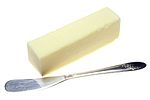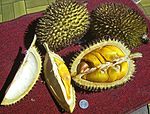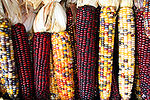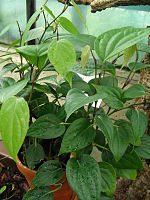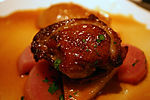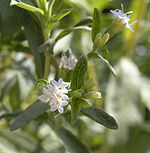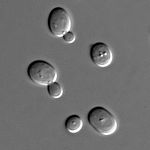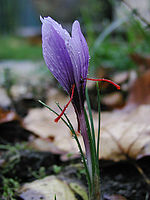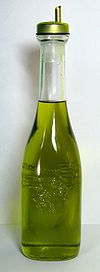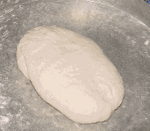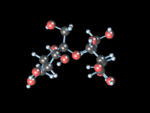- Portal:Food/Selected ingredient
-
These are the pictures that are featured on the Food portal main page.
If you wish to add a picture, you will be expected to make a good-faith effort to address any objections to the ingredient that may be raised. Consensus must be reached for an image to be given selected ingredient status. When adding a qualifying ingredient, it should be classified as a featured ingredient in Wikibooks. These ingredients can be found in the ingredients section of the Cookbook on Wikimedia Books.
Please follow the usage instructions listed below when placing a new ingredient here,
Selected content:
- Selected articles
- Selected pictures
- Selected people
- Selected recipes
- Selected ingredients
- Selected quotes
Selected content tools:
- What is a featured article?
- What is a featured list?
- What is a featured picture?
- What is a featured topic?
- What is a good article?
Usage
The template for used to configure these sub-pages is located {{Selected ingredient}}
- Look at Wiki Cookbook for the featured ingredient of the month.
- Add a new Selected article to the next available subpage.
- Update "max=" to new total for its {{Random portal component}} on the main page.
Selected ingredient 1
Butter is a dairy product made by churning fresh or fermented cream or milk. Butter is used as a spread and a condiment, as well as in cooking applications such as baking, sauce making, and frying. Butter consists of butterfat surrounding minuscule droplets consisting mostly of water and milk proteins. The most common form of butter is made from cows' milk, but it can also be made from the milk of other mammals, including sheep, goats, water buffalo, and yaks. Salt, flavorings, or preservatives are sometimes added to butter. Rendering butter produces clarified butter or ghee, which is almost entirely butterfat.
Portal:Food/Selected ingredient/1When refrigerated, butter remains a solid, but softens to a spreadable consistency at room temperature, and melts to a thin liquid consistency at 32–35 °C (90–95 °F). The density of butter is 911 kg/m3.[1] Butter generally has a pale yellow color, but varies from deep yellow to nearly white. The color of the butter depends on the animal's feed and is commonly manipulated with food colorings in the commercial manufacturing process, most commonly annatto or carotene.
The term "butter" is used in the names of products made from puréed nuts or peanuts, such as peanut butter. It is also used in the names of fruit products, such as apple butter. Other fats solid at room temperature are also known as "butters"; examples include cocoa butter and shea butter. In general use, the term "butter," when unqualified by other descriptors, almost always refers to the dairy product. The word butter, in the English language, derives (via Germanic languages) from the Latin butyrum, borrowed from the Greek boutyron. This may have been a construction meaning "cow-cheese" (bous "ox, cow" + tyros "cheese"), or the word may have been borrowed from another language, possibly Scythian.[2] The root word persists in the name butyric acid, a compound found in rancid butter and dairy products.
Selected ingredient 2
Black pepper (Piper nigrum) is a flowering vine in the family Piperaceae, cultivated for its fruit, which is usually dried and used as a spice and seasoning. The same fruit is also used to produce white pepper, red/pink pepper, and green pepper.[3] Black pepper is native to South India and is extensively cultivated there and elsewhere in tropical regions. The fruit, known as a peppercorn when dried, is a small drupe five millimetres in diameter, dark red when fully mature, containing a single seed.
Portal:Food/Selected ingredient/2Dried ground pepper is one of the most common spices in European cuisine and its descendants, having been known and prized since antiquity for both its flavour and its use as a medicine. The spiciness of black pepper is due to the chemical piperine. Ground black peppercorn, usually referred to simply as "pepper", may be found on nearly every dinner table in some parts of the world, often alongside table salt.
The word "pepper" is derived from the Sanskrit pippali, the word for long pepper via the Latin piper which was used by the Romans to refer both to pepper and long pepper, as the Romans erroneously believed that both of these spices were derived from the same plant. The English word for pepper is derived from the Old English pipor. The Latin word is also the source of German pfeffer, French poivre, Dutch peper, and other similar forms. In the 16th century, pepper started referring to the unrelated New World chile peppers as well. "Pepper" was used in a figurative sense to mean "spirit" or "energy" at least as far back as the 1840s; in the early 20th century, this was shortened to pep.
Selected ingredient 3
The durian (English pronunciation: /ˈdjʊəriən, -ɑn/) is the fruit of trees of the genus Durio belonging to the Malvaceae, a large family which includes hibiscus, okra, cotton, mallows and linden trees. Widely known and revered in Southeast Asia as the "King of Fruits," the fruit is distinctive for its large size, unique odour, and formidable thorn-covered husk. The fruit can grow up to 30 centimetres (12 in) long and 15 centimetres (6 in) in diameter, and typically weighs one to three kilograms (2 to 7 lbs). Its shape ranges from oblong to round, the colour of its husk green to brown, and its flesh pale-yellow to red, depending on the species.
Portal:Food/Selected ingredient/3The hard outer husk is covered with sharp, prickly thorns while the edible flesh within emits a distinctive odour, which is regarded as either fragrant or overpowering and offensive. The odour of the ripe fruit is strong and penetrating even when the husk is intact. Due to the unusual odour, the durian is forbidden from certain establishments such as hotels and public transportations in Southeast Asia. The odour has prompted many people to formulate evocative descriptions with views ranging from those of deep appreciation to intense disgust.
The durian, native to Brunei, Malaysia and Indonesia, has been known to the western world for about 600 years. The British naturalist Alfred Russel Wallace famously described its flesh as "a rich custard highly flavoured with almonds" in the 19th century. The flesh can be consumed at various stages of ripeness and is used to flavour a wide variety of savoury and sweet edibles in Southeast Asian cuisines. The seeds can also be eaten when cooked. The name durian comes from the Malay word duri (thorn) together with the suffix -an.
There are 30 recognised Durio species, at least nine of which produce edible fruit. Durio zibethinus is the only species available in the international market; other species are sold in their local regions. There are hundreds of durian cultivars; most of them have a common name and a code number starting with "D". Many consumers express preferences for specific cultivars, which fetch higher prices in the market.
Selected ingredient 4
Maize (pronounced /ˈmeɪz/) (Zea mays L. ssp. mays), known as corn in some countries, is a cereal grain domesticated in Mesoamerica and subsequently spread throughout the American continents. After European contact with the Americas in the late 15th century and early 16th century, maize spread to the rest of the world.
Portal:Food/Selected ingredient/4Maize is the largest crop in the Americas (270 million metric tons annually in the U.S. alone). Hybrid maize, due to its high grain yield due to heterosis ("hybrid vigour"), is preferred by farmers over conventional varieties. While some maize varieties grow 7 metres (23 ft) tall at certain locations, commercial maize has been bred for a height of 2.5 metres (8 ft). Sweet corn is usually shorter than field-corn varieties.
Selected ingredient 5
The apple is the pomaceous fruit of the apple tree, species Malus domestica in the rose family Rosaceae. It is one of the most widely cultivated tree fruits. The tree is small and deciduous, reaching 5–12 m tall, with a broad, often densely twiggy crown. The leaves are alternately arranged simple ovals 5–12 cm long and 3–6 cm broad on a 2–5 cm petiole with an acute tip, serrated margin and a slightly downy underside. Flowers are produced in spring simultaneous with the budding of the leaves. The flowers are white with a pink tinge that gradually fades, five petaled, 2.5–3.5 cm in diameter. The fruit matures in autumn, and is typically 5–9 cm diameter. The centre of the fruit contains five carpels arranged in a five-point star, each carpel containing one to three seeds.
Portal:Food/Selected ingredient/5The tree originated from Asia, where its wild ancestor is still found today. There are more than 7,500 known cultivars of apples resulting in range of desired characteristics. It should be noted however, that cultivars vary in their yield and the ultimate size of the tree, even when grown on the same rootstock.
At least 55 million tonnes of apples were grown worldwide in 2005, with a value of about $10 billion. China produced about two-fifths of this total. The United States is the second leading producer, with more than 7.5% of the world production. Turkey, France, Italy and Iran are among the leading apple exporters.
Selected ingredient 6
Cubeb (Piper cubeba), or tailed pepper, is a plant in genus Piper, cultivated for its fruit and essential oil. It is mostly grown in Java and Sumatra, hence sometimes called Java pepper. The fruits are gathered before they are ripe, and carefully dried. Commercial cubebs consist of the dried berries, similar in appearance to black pepper, but with stalks attached — the "tails" in "tailed pepper". The dried pericarp is wrinkled, its color ranges from grayish-brown to black. The seed is hard, white and oily. The odor of cubebs is described as agreeable and aromatic. The taste, pungent, acrid, slightly bitter and persistent. It has been described as tasting like allspice, or like a cross between allspice and black pepper.
Portal:Food/Selected ingredient/6Cubeb came to Europe via India through the trade with the Arabs. The name cubeb comes from Arabic kabāba (كبابة), which is of unknown origin, by way of Old French quibibes. Cubeb is mentioned in alchemical writings by its Arabic name. In his Theatrum Botanicum, John Parkinson tells that the king of Portugal prohibited the sale of cubeb in order to promote black pepper (Piper nigrum) around 1640. It experienced a brief resurgence in 19th century Europe for medicinal uses, but has practically vanished from the European market since. It continues to be used as a flavoring agent for gins and cigarettes in the West, and as a seasoning for food in Indonesia and Africa.
Selected ingredient 7
In culinary terminology, squab is the meat from a young domestic pigeon; formerly adult birds from several species were called by the same name. Squab for the table are roughly a month old; they have reached adult size but have not yet flown. Consumed throughout much of recorded history, squab is not usually a staple food where it is a part of modern cuisine, and it may be considered peculiar or exotic.
Portal:Food/Selected ingredient/7Selected ingredient 8
Stevia is a genus of about 150 species of herbs and shrubs in the sunflower family (Asteraceae), native to subtropical and tropical South America and Central America. The species Stevia rebaudiana Bertoni, commonly known as sweetleaf, sweet leaf, sugarleaf, or simply stevia, is widely grown for its sweet leaves. As a sugar substitute, stevia's taste has a slower onset and longer duration than that of sugar, although some of its extracts may have a bitter or licorice-like aftertaste at high concentrations.
Portal:Food/Selected ingredient/8With its extracts having up to 300 times the sweetness of sugar, stevia has garnered attention with the rise in demand for low-carbohydrate, low-sugar food alternatives. Stevia also has shown promise in medical research for treating such conditions as obesity and high blood pressure.
Stevia has a negligible effect on blood glucose, even enhancing glucose tolerance; However, health and political controversies have limited stevia's availability in many countries; for example, the United States banned it in the early 1990s unless labeled as a supplement. Stevia is widely used as a sweetener in Japan, and it is now available in the US and Canada as a dietary supplement, although not as a food additive. Rebiana is the trade name for a stevia-derived sweetener being developed jointly by The Coca-Cola Company and Cargill with the intent of marketing in several countries and gaining regulatory approval in the US and EU. Truvia is Cargill's consumer brand of Rebiana-based sweetener.
Selected ingredient 9
Yeasts are a growth form of eukaryotic microorganisms classified in the kingdom Fungi, with about 1,500 species described; they dominate fungal diversity in the oceans. Most reproduce asexually by budding, although a few do by binary fission. Yeasts are unicellular, although some species with yeast forms may become multicellular through the formation of a string of connected budding cells known as pseudohyphae, or false hyphae as seen in most molds. Yeast size can vary greatly depending on the species, typically measuring 3–4 µm in diameter, although some yeasts can reach over 40 µm.
Portal:Food/Selected ingredient/9The yeast species Saccharomyces cerevisiae has been used in baking and fermenting alcoholic beverages for thousands of years. It is also extremely important as a model organism in modern cell biology research, and is the most thoroughly researched eukaryotic microorganism. Researchers have used it to gather information into the biology of the eukaryotic cell and ultimately human biology. Other species of yeast, such as Candida albicans, are opportunistic pathogens and can cause infection in humans. Yeasts have recently been used to generate electricity in microbial fuel cells, and produce ethanol for the biofuel industry.
Yeasts do not form a specific taxonomic or phylogenetic grouping. At present it is estimated that only 1% of all yeast species have been described. The term "yeast" is often taken as a synonym for S. cerevisiae, however the phylogenetic diversity of yeasts is shown by their placement in both divisions Ascomycota and Basidiomycota. The budding yeasts ("true yeasts") are classified in the order Saccharomycetales.
Selected ingredient 10
Chocolate (pronounced
Portal:Food/Selected ingredient/10 /ˈtʃɒklət/ (help·info) or /-ˈələt/) comprises a number of raw and processed foods that are produced from the seed of the tropical cacao tree. Native to lowland, tropical South America, cacao has been cultivated for at least three millennia in Central America and Mexico, with its earliest documented use around 1100 BC. The majority of the Mesoamerican peoples made chocolate beverages, including the Maya and Aztecs, who made it into a beverage known as xocolātl, a Nahuatl word meaning "bitter water". The seeds of the cacao tree have an intense bitter taste, and must be fermented to develop the flavor. After fermentation, the beans are dried, cleaned, and roasted, and the shell is removed to produce cacao nibs. The nibs are then ground and liquified, resulting in pure chocolate in fluid form: chocolate liquor. The liquor can be further processed into two components: cocoa solids and cocoa butter.
/ˈtʃɒklət/ (help·info) or /-ˈələt/) comprises a number of raw and processed foods that are produced from the seed of the tropical cacao tree. Native to lowland, tropical South America, cacao has been cultivated for at least three millennia in Central America and Mexico, with its earliest documented use around 1100 BC. The majority of the Mesoamerican peoples made chocolate beverages, including the Maya and Aztecs, who made it into a beverage known as xocolātl, a Nahuatl word meaning "bitter water". The seeds of the cacao tree have an intense bitter taste, and must be fermented to develop the flavor. After fermentation, the beans are dried, cleaned, and roasted, and the shell is removed to produce cacao nibs. The nibs are then ground and liquified, resulting in pure chocolate in fluid form: chocolate liquor. The liquor can be further processed into two components: cocoa solids and cocoa butter.
Pure, unsweetened chocolate contains primarily cocoa solids and cocoa butter in varying proportions. Much of the chocolate consumed today is in the form of sweet chocolate, combining chocolate with sugar. Milk chocolate is sweet chocolate that additionally contains milk powder or condensed milk. "White chocolate" contains cocoa butter, sugar, and milk but no cocoa solids (and thus does not qualify to be considered true chocolate). Chocolate contains alkaloids such as theobromine and phenethylamine, which have physiological effects on the body. It has been linked to serotonin levels in the brain. Scientists claim that chocolate, eaten in moderation, can lower blood pressure. Dark chocolate has recently been promoted for its health benefits, including a substantial amount of antioxidants that reduce the formation of free radicals, though the presence of theobromine renders it toxic to some animals, such as dogs and cats.
Chocolate has become one of the most popular flavors in the world. Gifts of chocolate molded into different shapes have become traditional on certain holidays: chocolate bunnies and eggs are popular on Easter, chocolate coins on Hanukkah, Santa Claus and other holiday symbols on Christmas, and hearts on Valentine's Day. Chocolate is also used in cold and hot beverages, to produce chocolate milk and hot chocolate.
Selected ingredient 11
Saffron (pronounced /ˈsæfrən/, /ˈsæfrɒn/) is a spice derived from the dried stigma of the flower of the saffron crocus (Crocus sativus), a species of crocus in the family Iridaceae. The flower has three stigmas, which are the distal ends of the plant's carpels. Together with its style, the stalk connecting the stigmas to the rest of the plant, these components are often dried and used in cooking as a seasoning and coloring agent. Saffron, which has for decades been the world's most expensive spice by weight,[4][5] is native to Southwest Asia.[5][6] Saffron is known as 'Kesar' in India.
Portal:Food/Selected ingredient/11Saffron is characterized by a bitter taste and an iodoform- or hay-like fragrance; these are caused by the chemicals picrocrocin and safranal.[7][8] It also contains a carotenoid dye, crocin, that gives food a rich golden-yellow hue. These traits make saffron a much-sought ingredient in many foods worldwide. Saffron also has medicinal applications.
The word saffron originated from the 12th-century Old French term safran, which derives from the Latin word safranum. Safranum is also related to the Italian zafferano and Spanish azafrán.[9] Safranum comes from the Arabic word aṣfar (أَصْفَر), which means "yellow," via the Persian paronymous zaʻfarān (زَعْفَرَان).
Selected ingredient 12
Olive oil is a fruit oil obtained from the olive (Olea europaea; family Oleaceae along with lilacs, jasmine and ash trees), a traditional tree crop of the Mediterranean Basin. The wild olive tree originated in Asia Minor, today the countries of Turkey, Syria, and Lebanon.[10] It is commonly used in cooking, cosmetics, pharmaceuticals, and soaps and as a fuel for traditional oil lamps.
Portal:Food/Selected ingredient/12The olive tree is native to the Mediterranean basin; wild olives were collected by Neolithic peoples as early as the 8th millennium BC. The wild olive tree originated in Asia Minor in modern Turkey. It is not clear when and where olive trees were first domesticated: in Asia Minor in the 6th millennium[11]; along the Levantine coast stretching from the Sinai Peninsula to modern Turkey in the 4th millennium[12]; or somewhere in the Mesopotamian Fertile Crescent in the 3rd millennium.
Selected ingredient 13
Dough (Pâte in French, Pasta in Italian) is a paste made out of the flour of any cereal (grain) or leguminous food, moistened and kneaded but not baked. This step is a precursor to its use in cooking in numerous ways such as making bread, pasta, noodles, pastry, cookies and muffins among other uses. Dough differs from batter in having a lower water content.
Portal:Food/Selected ingredient/13Selected ingredient 14
Sucrose (common name: table sugar, also called saccharose) is a disaccharide of glucose and fructose with an α (alpha) 1,2 glycosidic linkage. The molecular formula of sucrose is C12H22O11. Its systematic name is β-D-fructofuranosyl-(2→1)-α-D-glucopyranoside (ending in "oside", because it's not a reducing sugar). It is best known for its role in human nutrition and is formed by plants but not by other organisms including animals. Pure sucrose is most often prepared as a fine, white, odorless, crystalline powder with a pleasing, sweet taste: the common table sugar. Sucrose is generally isolated from natural sources, however its chemical synthesis was first achieved in 1953 by Raymond Lemieux.
Portal:Food/Selected ingredient/14Like other carbohydrates, sucrose has a hydrogen to oxygen ratio of 2:1. It consists of two monosaccharides, α-glucose and fructose, joined by a glycosidic bond between carbon atom 1 of the glucose unit and carbon atom 2 of the fructose unit. What is notable about sucrose is that unlike most disaccharides, the glycosidic bond is formed between the reducing ends of both glucose and fructose, and not between the reducing end of one and the nonreducing end of the other. The effect of this inhibits further bonding to other saccharide units. Since it contains no anomeric hydroxyl groups, it is classified as a nonreducing sugar. Acidic hydrolysis can be used in laboratories to achieve the hydrolysis of sucrose into glucose and fructose.
Sucrose melts and decomposes at 186 °C (367 °F) to form caramel, and when combusted produces carbon, carbon dioxide, and water. Water breaks down sucrose by hydrolysis, however the process is so gradual that it could sit in solution for years with negligible change. If the enzyme sucrase is added however, the reaction will proceed rapidly.
Selected ingredient 15
Portal:Food/Selected ingredient/15Selected ingredient 16
Portal:Food/Selected ingredient/16Selected ingredient 17
Portal:Food/Selected ingredient/17Selected ingredient 18
Portal:Food/Selected ingredient/18Selected ingredient 19
Portal:Food/Selected ingredient/19Selected ingredient 20
Portal:Food/Selected ingredient/20Selected ingredient 21
Portal:Food/Selected ingredient/21 Portal:Food/Selected ingredient/21Selected ingredient 22
Portal:Food/Selected ingredient/22 Portal:Food/Selected ingredient/22Selected ingredient 23
Portal:Food/Selected ingredient/23 Portal:Food/Selected ingredient/23Selected ingredient 24
Portal:Food/Selected ingredient/24 Portal:Food/Selected ingredient/24Selected ingredient 25
Portal:Food/Selected ingredient/25 Portal:Food/Selected ingredient/25Selected ingredient 26
Portal:Food/Selected ingredient/26 Portal:Food/Selected ingredient/26Selected ingredient 27
Portal:Food/Selected ingredient/27 Portal:Food/Selected ingredient/27Selected ingredient 28
Portal:Food/Selected ingredient/28 Portal:Food/Selected ingredient/28Selected ingredient 29
Portal:Food/Selected ingredient/29 Portal:Food/Selected ingredient/29Selected ingredient 30
Portal:Food/Selected ingredient/30 Portal:Food/Selected ingredient/30Selected ingredient 31
Portal:Food/Selected ingredient/31 Portal:Food/Selected ingredient/31Selected ingredient 32
Portal:Food/Selected ingredient/32 Portal:Food/Selected ingredient/32Selected ingredient 33
Portal:Food/Selected ingredient/33 Portal:Food/Selected ingredient/33Selected ingredient 34
Portal:Food/Selected ingredient/34 Portal:Food/Selected ingredient/34Selected ingredient 35
Portal:Food/Selected ingredient/35 Portal:Food/Selected ingredient/35Selected ingredient 36
Portal:Food/Selected ingredient/36 Portal:Food/Selected ingredient/36Selected ingredient 37
Portal:Food/Selected ingredient/37 Portal:Food/Selected ingredient/37Selected ingredient 38
Portal:Food/Selected ingredient/38 Portal:Food/Selected ingredient/38Selected ingredient 39
Portal:Food/Selected ingredient/39 Portal:Food/Selected ingredient/39Selected ingredient 40
Portal:Food/Selected ingredient/40 Portal:Food/Selected ingredient/40Selected ingredient 41
Portal:Food/Selected ingredient/41 Portal:Food/Selected ingredient/41Selected ingredient 42
Portal:Food/Selected ingredient/42 Portal:Food/Selected ingredient/42Selected ingredient 43
Portal:Food/Selected ingredient/43 Portal:Food/Selected ingredient/43Selected ingredient 44
Portal:Food/Selected ingredient/44 Portal:Food/Selected ingredient/44Selected ingredient 45
Portal:Food/Selected ingredient/45 Portal:Food/Selected ingredient/45Selected ingredient 46
Portal:Food/Selected ingredient/46 Portal:Food/Selected ingredient/46Selected ingredient 47
Portal:Food/Selected ingredient/47 Portal:Food/Selected ingredient/47Selected ingredient 48
Portal:Food/Selected ingredient/48 Portal:Food/Selected ingredient/48Selected ingredient 49
Portal:Food/Selected ingredient/49 Portal:Food/Selected ingredient/49Selected ingredient 50
Portal:Food/Selected ingredient/50 Portal:Food/Selected ingredient/50
Cite error: There are<ref>tags on this page, but the references will not show without a{{Reflist}}template or a<references />tag; see the help page.Categories:- Food portal
Wikimedia Foundation. 2010.

